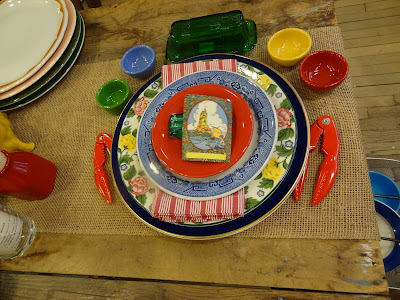 |
| Hiroko Shimbo on shio-koji. |
As I mentioned in an earlier post, I’ve been learning a lot
about fermentation, Japanese style. After learning about the healthy
properties of miso, I attended a talk by Japanese food expert, chef-instructor,
cookbook author and consultant Hiroko
Shimbo on the topic of shio-koji, the
ingredient Japanese have fallen in love with for its flavor enhancing and
tenderizing abilities.
Shio-koji is the miracle
marinade, seasoning and tenderizer that’s made from a simple mixture of a
substance called koji, sea salt and
water It's the enzymes in shio-koji--protease, lipase and amylase—that act as tenderizers.
To understand shio-koji, you first need to
understand koji, the mold-innoculated
rice integral to making Japan’s favorite fermented grain products: soy sauce,
miso, mirin (rice wine vinegar) and saké. Koji plays the key role
of breaking down the starch of grains and converting it to glucose, and has
been commercially available in Japan since the 14th century. You can find it at most good Japanese food markets. Even in small doses, koji teams with life; a teaspoon of koji
contains about 100 million yeast cells.
Make shio-koji isn’t
hard, that is if you don’t mind stirring your batch 100 times a day and
letting it develop for five to ten days (it takes longer to ferment in the
winter). At the recent International Restaurant and Food Service Show in
New York City earlier this month, where she was a featured speaker, Shimbo demonstrated
how to do it by mixing together koji sea salt and water in a ratio of 3:1:5. Check
out Shimbo’s shio-koji
recipe, for details. Since New York City has even softer water than
Kyoko or Tokyo, she noted, we're lucky to be able to use water straight from the
tap.
 |
| The possible uses of shio- and shoyu-koji boggle the mind. |
If audience members had any doubts that this whole shio-koji thing is for real, Shimbo
banished them with a parade of delectable sample dishes made using commercially
available shio-koji and shoyu-koji from Marukome (the latter
essentially made by substituting soy sauce for the salt and water). While shio-koji is best for fish, chicken and
vegetables, shoyu-koji, explained
Shimbo, is great with more robust
meat or fowl such as pork, beef or chicken.
She passed out tender and umami-infused
morsels of chicken that had been marinated overnight in shio-koji. Whole chickens should be marinated overnight, but if
you’re working with small piece of chicken, a quick 30-minute marinade will do
the trick; for white fish, an hour will suffice. Shimbo likes to use three
parts shio-koji to one part mirin for her marinade. Since it’s salty,
there’s no need for additional seasoning. Shimbo dressed a delicious Brussels
sprouts and petit tomatoes salad with a mixture of shio-koji, mustard, rice vinegar, honey, canola oil.
The general rule for marinating, Shimbo instructed, is that the
marinade should amount to 10 percent of the total weight of the food you are preparing.
We also tried a salty, thick and creamy tofu-yo, an Okinawan regional specialty that I first tasted at
David Bouley’s Brushstroke,
in which tofu is marinated in red koji,
malt, and a type of local distilled rice alcohol, awamori. Shimbo improvised her version of tofu-yo by keeping it submerged in a 3:1:1 ration of shiokoji, mirin and sake for two weeks. The tofu-yo was the exception to the 10 percent rule, resulting in an
umami bomb with the texture of cream cheese and the funky saltiness of blue
cheese.
The possible uses of shio-koji
boggle the mind: you can use it with olive oil to dress cold pasta, tomato,
and red onion, for dipping sauces or in stir frys, Shimbo suggests, or as she
did, to tenderize and pump up the flavor of Turkish-style lamb meatballs. Happy
experimenting!










